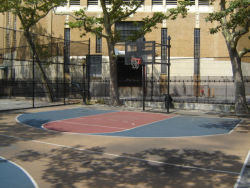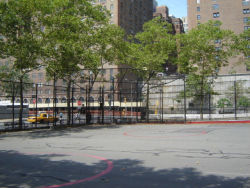Robert Moses Playground
Robert Moses Playground
"Parks are the outward visible symbol of democracy."
--Robert Moses, 1956
In five decades of public service, Robert Moses (1888-1981) had an extraordinary impact on the physical environment of New York. He played a primary role in the development of its parks, transportation, and housing. Moses was born on December 18, 1888 in New Haven, Connecticut. He graduated from Yale in 1909, received a jurisprudence degree from Oxford University in 1911, and a Ph.D. in political science from Columbia University in 1914.
Moses began his career in the public interest in 1913 as a municipal investigator. Beginning in 1924, Moses held a dozen City and State positions, many concurrently, including: Chairman of the Triborough Bridge and Tunnel Authority (TBTA), New York City Construction Coordinator, and sole member of the New York City Parkway Authority. Invested with this authority, Moses constructed 416 miles of highway and thirteen bridges, and thus reached his goal of bringing New York into the automobile era.
Moses entered into his legendary association with parks through Governor Alfred E. Smith. In 1924 he was appointed Chairman of the Long Island State Park Commission and President of the New York State Parks Council. On January 18, 1934, Moses was sworn in by Mayor Fiorello H. LaGuardia as Commissioner of the first unified, citywide Department of Parks, a position he held for 26 years, until he resigned to head the 1964-65 World’s Fair.
In the course of his remarkable career, Moses was responsible for an unprecedented number of physical expansions and improvements. During the Depression year Moses successfully matched his vision for parks with the resources provided by the Works Progress Administration, a federal social program. With over 80,000 laborers and 1,840 architects and engineers at its disposal in 1935, Parks was able to launch projects such as the Riverside Park extension, Flushing Meadows Corona Park and the building of 11 swimming pools. From 1934 to 1960, park acreage more than doubled, to 34,673 acres. Other projects included the addition of 658 playgrounds, 17 miles of beach, zoos, recreation centers, and ballfields. Moses was removed from his last public office when the TBTA was abolished by Governor Nelson A. Rockefeller in 1968.
Situated just south of the United Nations , this full-block site was acquired by the city in 1937 as part of the Queens-Midtown Tunnel construction, another Moses undertaking. The playground, which was completed in 1941, shares the block with the tunnel’s ventilating tower. The site was named for Moses by the City Council in 1982, when there was a proposal to build an apartment tower on it.
Check out your park's Vital Signs
Clean & Safe
Green & Resilient
Empowered & Engaged Users
Share your feedback or learn more about how this park is part of a
Vital Park System



